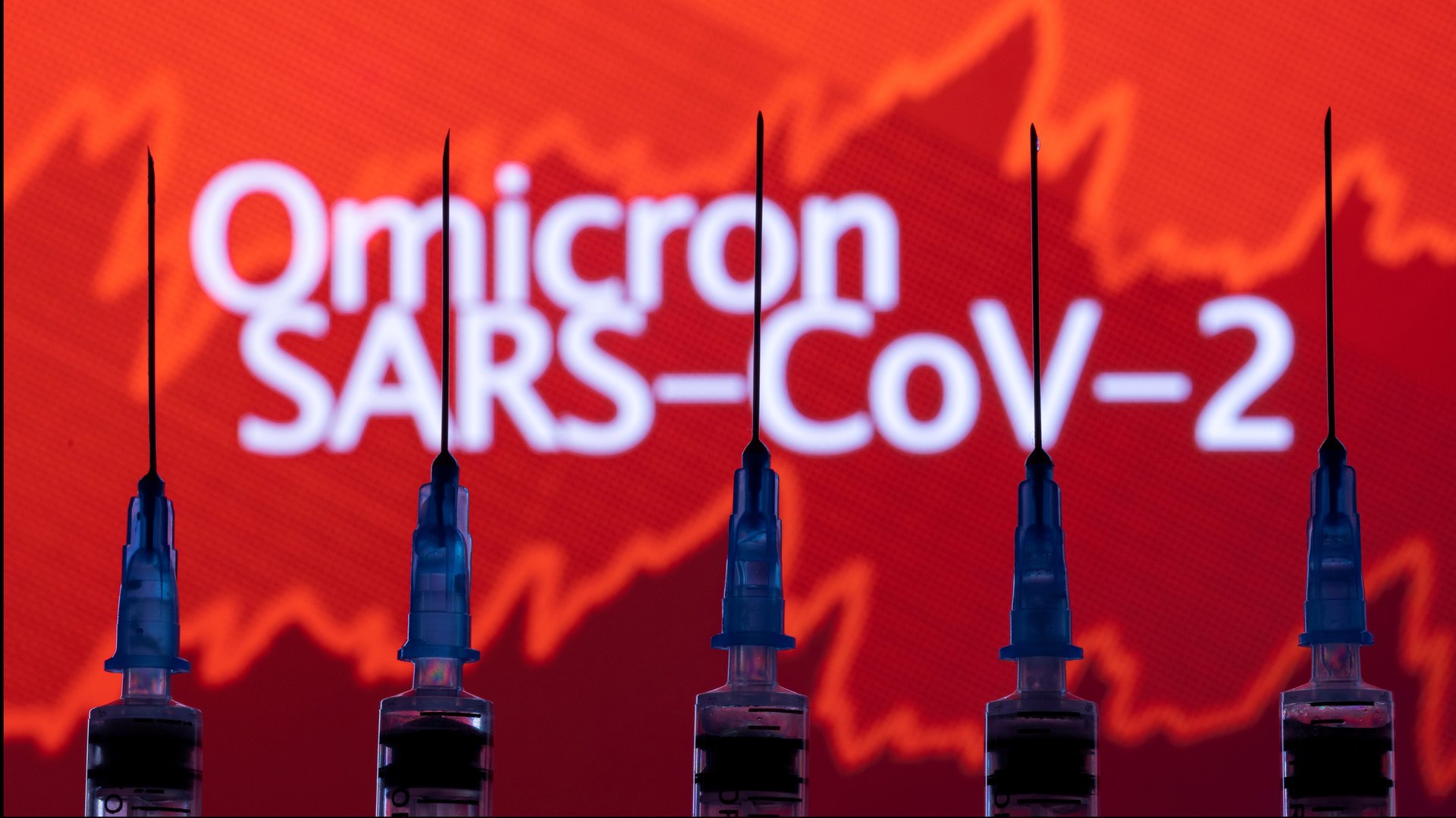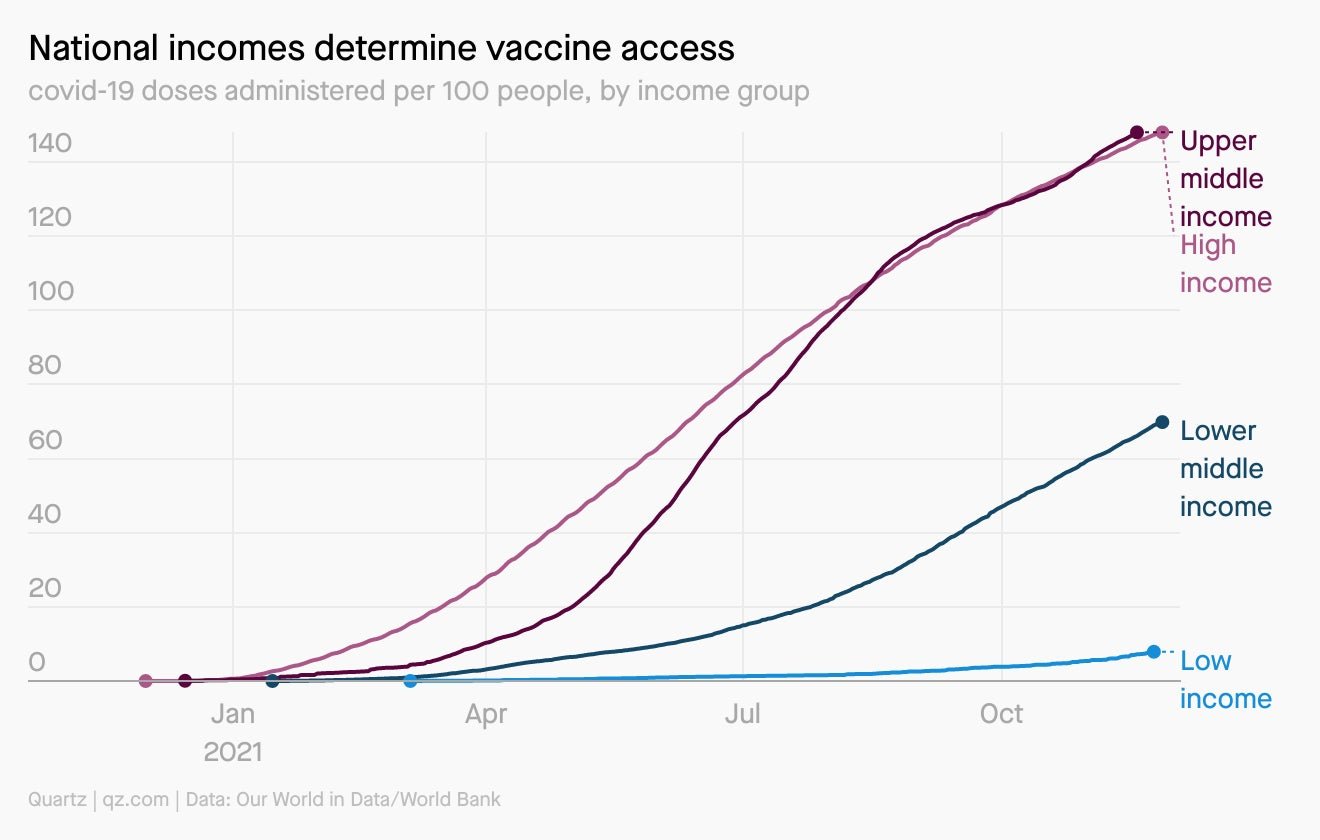Global warning
Hi Quartz readers,


Hi Quartz readers,
Since covid-19 vaccines were first released, public health experts have warned that until the world is vaccinated, unprotected hot spots could breed dangerous new variants. As the omicron variant is now demonstrating, it’s a warning rich countries have largely not heeded.
When new variants emerge, countries tend to restrict travel from other countries, even though such measures invariably arrive after infections have already crossed borders (see: India and the delta variant). A better policy would be a pre-emptive one—a concerted effort to reduce the number of unvaccinated people globally, giving the virus fewer opportunities to replicate and improve itself.
Yet vaccine access remains starkly unequal. A staggering 27 million covid-19 vaccine doses are administered each day, but most of them are going to citizens of high-income and upper-middle-income countries. According to WHO data, as of Nov. 23, 64% of people from high-income countries had received at least one dose, compared with less than 8% of people from low-income nations.

Covax, the global initiative for rich countries to donate to poorer ones, has repeatedly missed targets. Negotiations at the World Trade Organization, spearheaded by India and South Africa, to waive vaccine patents so that lower income countries can manufacture generic versions of Pfizer and Moderna’s vaccines have been deadlocked for months, due to opposition from the EU, UK, and Switzerland.
Meanwhile, rich countries are stockpiling vaccines that they aren’t using, exacerbating the inequity. According to one estimate, 60% of the vaccines produced in the world are bought by the US, UK, EU, Canada, and Japan. Between a third and half of those vaccines are hoarded rather than used, with the stockpile expected to grow to an estimated 1.2 billion unused doses by the end of the year.
For now, very little is known about omicron. While the variant was first sequenced in South Africa, that doesn’t necessarily mean it emerged there, and it has been detected in a number of other countries. It could turn out to be nothing, or it could shift the dynamics of how, and when, the world can reopen. Either way, it is a stark reminder that vaccine inequality anywhere will continue to prove a risk everywhere.
More intel on omicron
- Why is the omicron variant called B.1.1.529?
- How to pronounce “omicron” in English
- What are the symptoms of the omicron variant?
- When will we know about vaccines and omicron?
- Oil traders are increasingly paranoid about variants
- How omicron is isolating southern Africa
- Will omicron wreck the economic recovery?
- How will omicron affect the restaurant industry?
- Omicron shows the danger of treating coronavirus like an emergency
Words of wisdom
“When you have a virus that is showing this degree of transmissibility and you’re already having travel-related cases… in Israel and Belgium and in other places—when you have a virus like this, it almost invariably is ultimately going to go essentially all over.” —Anthony Fauci, director of the National Institute of Allergy and Infectious Diseases, on Sunday
Talking points
🙃 “Supply chain” has gone from jargon to meme. For people who actually work in the industry, the experience of becoming embedded in pop culture is novel, to say the least.
🏠 The US housing boom is not a bubble. Tight supply, rising demand, and a new generation of buyers—not lax lending standards—are driving the current growth.
🚢 The world’s big shipping lines have pandemic profits to spend. Some are expanding into new, lucrative lines of business, like cruise ships and cargo planes.
📈 One economic recovery is going strong. Pending omicron developments, forecasters are expecting the US economy to grow quickly in the fourth quarter.
🛫 Supply chain chaos has moved to airports. Retailers who want to get last-minute goods in for the holidays will have to pay top dollar to get their cargo delivered by air.
The state of things
In today’s China, the civil service exam, called guokao, is still the prevalent way of appointing junior government workers. And in a sign of the mounting difficulty of finding a job, a record 2.1 million applicants registered for this year’s test. The number of applicants that actually took the exam was 1.4 million, meaning there were 46 people competing for each of 31,200 available posts.

The jump in applicants comes as China’s youngsters are under unprecedented pressure. On-and-off covid outbreaks have disrupted daily lives and business, and the government’s crackdowns on sectors like education have forced many companies to shutter. According to China’s national statistics bureau, the unemployment rate for those aged 19 to 24 stood at 14.2% in October.
Leading with empathy
The pandemic has added a fresh sense of urgency to the notion of extending compassion and understanding to employees—now the onus is on managers. Here’s what you need to know:
🖤 In a tight talent market, companies should consider empathy-driven changes they could implement to retain staffers.
🌟 Nearly three-quarters of employees who work for empathetic leaders say they feel engaged at work, vs. 32% of those with less empathetic leaders.
🧠 Cognitive empathy, or the ability to understand others’ perspectives, may be more valuable than emotional empathy, or feeling what others feel.

✦ Want more intel on empathetic management? Check out this week’s forecast, available to Quartz members. To get future forecasts directly in your inbox, try membership for free.
Elsewhere on Quartz
- Quick question: Will China be as unequal as the US is by 2025?
- Lone stars: Texas has zero working-class legislators
- It pays: Jack Dorsey chose Square over Twitter
- Walled garden: Apple can actually populate the metaverse
- Versailles in Manila: IKEA just opened its larger store ever
Our best wishes for a healthy day. Get in touch with us at [email protected], and live your best Quartz life by downloading our iOS app and becoming a member. Today’s newsletter was brought to you by Aurora Almendral, Jane Li, Sarah Todd, and Kira Bindrim.